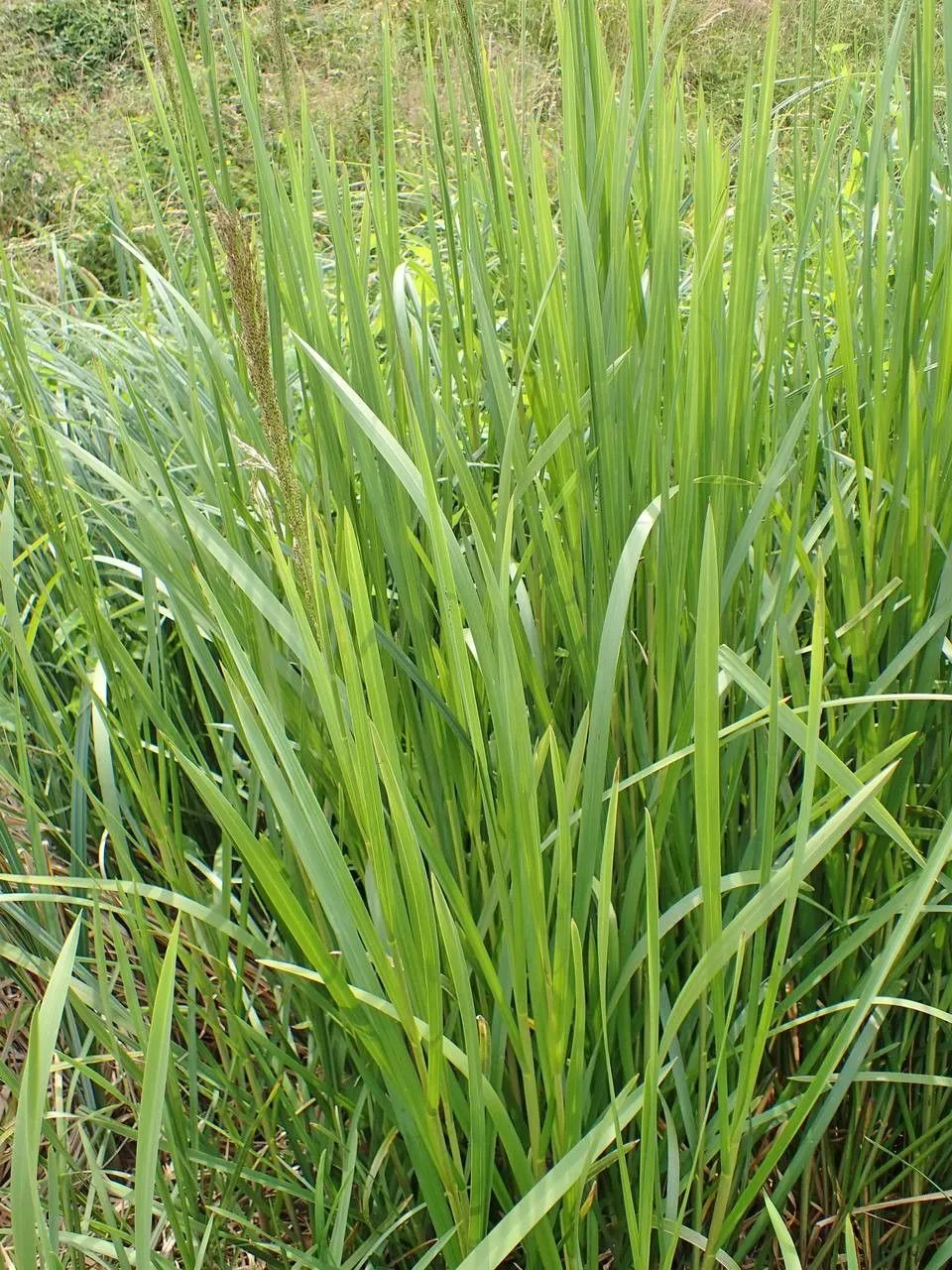
Author: (Hartm.) Holmb.
Bibliography: Bot. Not. 1919: 97 (1919)
Year: 1919
Status: accepted
Rank: species
Genus: Glyceria
Vegetable: False
Observations: Europe to Xinjiang
Reed sweet grass, known scientifically as Glyceria maxima, is a prominent species within the Poaceae family. Originating from the lush regions of Europe, its range extends as far as the picturesque Xinjiang. The plant holds a historical significance in botanical literature, first documented and authored in a 1919 publication, “Botaniska Notiser,” by the renowned (Hartm.) Holmb.
This perennial grass is characterized by its robust and expansive growth, often found in wetlands, riverbanks, and marshy areas. Its towering height and dense clusters make it an essential component of the aquatic plant community, providing habitat and shelter for numerous wildlife species. The adaptability of Glyceria maxima allows it to thrive in varying water conditions, showcasing its vitality and ecological importance.
Reed sweet grass also plays a crucial role in soil and water conservation. Its root system helps in stabilizing soil, thereby preventing erosion, while its presence in water bodies aids in maintaining water quality by filtering pollutants and offering habitat structure for aquatic organisms.
This species has been the subject of extensive botanical studies due to its wide distribution and ecological impact. Its documentation in early 20th-century botanical literature marked the beginning of significant research and interest in its role within its native ecosystems.
The broad geographical span from Europe to the distant Xinjiang region reflects the plant’s resilient nature and its ability to adapt to diverse climatic conditions. Reed sweet grass stands as a vital species within the Poaceae family, contributing to the richness and biodiversity of habitats across its range.
Deu: grosses süeegras, großer schwaden, wasser-schwaden
Dan: høj sødgræs
Eng: reed sweet grass, reed sweet-grass, reed mannagrass, reed-meadow grass, water-meadow grass, rough mannagrass, english watergrass, giant mannagrass, great water grass, reed meadowgrass, tall glyceria
Nor: elvekonge
Fra: glycérie aquatique, grande glycérie
Swe: jättegröe, kasevia
Nld: liesgras
Sme: stuorrarávesuoidni
Cym: chwegwellt, gweunwellt y dŵr, melyswellt y gamlas, perwellt
En: Reed sweet grass, Reed-meadow grass, Water-meadow grass, Reed mannagrass, Reed Sweet-grass, Reed Manna Grass, Rough mannagrass, English watergrass, Great Water Grass, Giant mannagrass, Reed meadowgrass, Tall glyceria, Reed Manna-grass
Zh: 水甜茅
Cs: Zblochan vodní
Da: Høj Sødgræs
Nl: Liesgras
Et: Suur parthein
Fi: Isosorsimo
Fr: Glycérie aquatique, Grande glycérie, Glycérie très élevée
De: Grosses Süeegras, Wasser-Schwaden, Großer Schwaden, Großes Süßgras
Hu: Vízi harmatkása
Is: Fenjapuntur
Ga: Milseán mór
It: Gramignone maggiore
Lt: Vandeninė monažolė
Se: Stuorrarávesuoidni
No: Elvekonge
Pl: Manna mielec
Pt-br: Glicéria-maior
Sv: Jättegröe, Kasevia
Uk: Лепешняк великий
Cy: Melyswellt y gamlas, Chwegwellt, Gweunwellt y Dŵr, Perwellt
© copyright of the Board of Trustees of the Royal Botanic Gardens, Kew.
© copyright of the Board of Trustees of the Royal Botanic Gardens, Kew.
© copyright of the Board of Trustees of the Royal Botanic Gardens, Kew.
Taken Jul 11, 2021 by Philippe Delaveau (cc-by-sa)
Taken Jul 5, 2022 by yvon s (cc-by-sa)
Taken Jun 20, 2017 by Yoan MARTIN (cc-by-sa)
Taken Jul 23, 2022 by Mar. Hoogeland (cc-by-sa)
Taken Jul 26, 2014 by Tela Botanica − Marie PORTAS (cc-by-sa)
Taken Jul 13, 2021 by Wil Ooms (cc-by-sa)
Taken Jun 27, 2021 by Laurent Colombet (cc-by-sa)
Taken Jul 22, 2020 by Richard Thomas (cc-by-sa)
Taken Jun 18, 2020 by Denis Denis LEBERT (cc-by-sa)
Taken Jul 12, 2014 by Tela Botanica − Florent BECK (cc-by-sa)
Taken Jun 20, 2017 by Yoan MARTIN (cc-by-sa)
Taken Jun 20, 2017 by Yoan MARTIN (cc-by-sa)
Taken Jun 27, 2021 by Laurent Colombet (cc-by-sa)
Taken Jul 12, 2014 by Tela Botanica − Florent BECK (cc-by-sa)
Taken Jun 11, 2015 by Tela Botanica − Florent BECK (cc-by-sa)
Taken Jul 15, 2005 by Photoflora – Benoit BOCK (©)
Taken Sep 15, 2008 by Photoflora – Benoit BOCK (©)
Taken Jun 20, 2017 by Yoan MARTIN (cc-by-sa)
Taken Jul 26, 2014 by Tela Botanica − Marie PORTAS (cc-by-sa)
Taken Jul 26, 2014 by Tela Botanica − Marie PORTAS (cc-by-sa)
Taken Jul 12, 2014 by Tela Botanica − Florent BECK (cc-by-sa)
Taken Jul 12, 2014 by Tela Botanica − Florent BECK (cc-by-sa)
Taken Jul 12, 2014 by Tela Botanica − Florent BECK (cc-by-sa)
Taken Jul 12, 2014 by Tela Botanica − Florent BECK (cc-by-sa)
Taken May 8, 2020 by dez keg (cc-by-sa)
Taken Jan 1, 1970 by Photoflora – L’Abbé COSTE (©)
Taken Aug 15, 2014 by Photoflora – Benoit BOCK (©)
Taken Jul 18, 2013 by Tela Botanica − Bertrand BUI (cc-by-sa)
Taken Jan 1, 1800 by Tela Botanica − Daniel MATHIEU (cc-by-sa)
Taken Jul 26, 2014 by Tela Botanica − Marie PORTAS (cc-by-sa)
Growth habit: Graminoid
Ph maximum: 8.0
Ph minimum: 7.5
Light: 8
Atmospheric humidity: 8
Bloom months: [‘jun’, ‘jul’, ‘aug’]
Soil nutriments: 9
Family: Myrtaceae Author: (F.Muell.) K.D.Hill & L.A.S.Johnson Bibliography: Telopea 6: 402 (1995) Year: 1995 Status:…
Family: Rubiaceae Author: Pierre ex A.Froehner Bibliography: Notizbl. Bot. Gart. Berlin-Dahlem 1: 237 (1897) Year:…
Family: Sapindaceae Author: Koidz. Bibliography: J. Coll. Sci. Imp. Univ. Tokyo 32(1): 38 (1911) Year:…
Family: Asteraceae Author: A.Gray Bibliography: Pacif. Railr. Rep.: 107 (1857) Year: 1857 Status: accepted Rank:…
Family: Fabaceae Author: Medik. Bibliography: Vorles. Churpfälz. Phys.-Ökon. Ges. 2: 398 (1787) Year: 1787 Status:…
Family: Aspleniaceae Author: (Cav.) Alston Bibliography: Bull. Misc. Inform. Kew 1932: 309 (1932) Year: 1932…